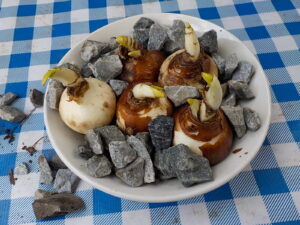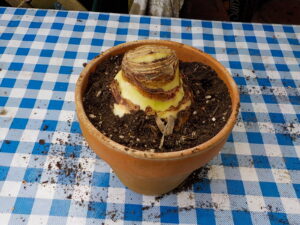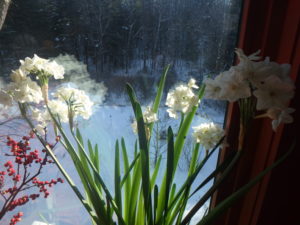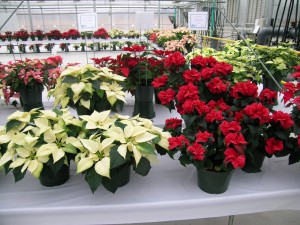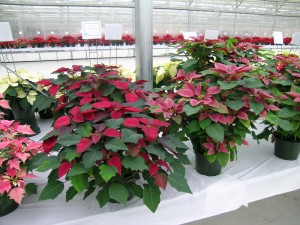Winter Plantings: Paperwhites and Amaryllis
As winter drags along, I long for warm sun and green plants surrounding me outdoors. It’s much too early to start spring seeds (even indoors), but I can plant some flower bulbs. I love paperwhites and amaryllis, and both are readily available for planting now – and they will bloom indoors while it snows outside.
I should warn you that paperwhites have strong scents, and not everyone is enthralled with their smell. But I like the scent, which I can smell once I walk into a room with freshly blooming paperwhites. If you don’t like strong-smelling musky scents, there is one variety that is barely fragrant: ‘Grand Soleil d’Or’. Instead of the traditional white blossoms, these bulbs produce gold or yellow blossoms.
A more expensive – but more dramatic – flower for forcing is amaryllis. This is a tropical flower originally from South Africa – and many are still imported from there each year. Properly cared for, your investment in an amaryllis bulb will produce a plant that will last for up to 75 years, blooming every year!
Paperwhites and Amaryllis: Start Some for Easy Blossoms Indoors
The winter months can be a bit depressing for me. As a gardener there is very little to do, and my supply of colorful flowers indoors is limited. I combat this by buying cut flowers, and better yet, getting flowers to bloom in pots or dishes for me. Two of my favorites are paperwhites and amaryllis. I have both blooming right now, and will continue to start more.
Paperwhites are in the daffodil family in the genus Narcissus. There are many named cultivars, but most purveyors of the bulbs do not tell you their names. Commonly sold in grocery stores and garden centers, paperwhites are easy cultivate and quick to bloom. Some varieties will bloom in a couple of weeks, others take up to a month.
To get your paperwhites to bloom, all you need is a sunny windowsill, a dish or bowl that will hold water, and some small stones. Garden centers sell bags of attractive pebbles or chips of white marble that is suitable, or you can go out to your driveway and pick up stones.
Start by rinsing off the pebbles and placing them in a wide, low bowl. Then arrange your paperwhites so that the fat end of each bulb is nestled into the stones and surrounded by them. Add enough water so that it just “kisses” the bottom of the bulbs. You don’t want the bulb sitting in water – the bulbs can rot if they do.
I like to select paperwhites from the bin that have green sprouts already emerging at the time of purchase. They will bloom sooner than those that are entirely dormant at the time of purchase. If you buy them in a mesh bag, look at the bulbs carefully to make sure they are not dried out or are mushy when you squeeze them.
Paperwhites have a distinctive fragrance which can be quite strong. I love the sweet scent, but not everyone does. At this time of year any flower scent is a blessing, as far as I am concerned. The odor can often be smelled from quite a distance. One variety that does not have an odor is a bright yellow one called ‘Grand Soleil d’Or’.
Unlike the ordinary daffodils that I pot up in soil each fall and force to bloom indoors in the spring, paperwhites cannot be successfully planted outdoors, even if you kept them watered and green until the ground thaws. They are a Mediterranean species, and will not survive our winters. I don’t believe they will bloom again next year indoors, either. But that means there is one less chore to do.
Amaryllis is another easy, bright and wonderful flower that you can plant at this time of year for indoor blooms. The bulbs are available in grocery stores, Big Box stores and garden centers. Some come already planted in pots, but most come with a bag of planting soil, a pot, and a bulb – so some assembly is required.
The flowers of amaryllis bloom on a 16-inch stem and are shaped like Oriental or Asiatic lilies. The come in red, white, pink and striped varieties. None are particularly fragrant. As with most things, you get what you pay for. If you get the least expensive, smallest bulbs you will get one stem with 4 blossoms on a single stem. If you buy a bigger bulb, you will probably get 2 flower stems, one growing after the first has finished blooming. I’ve even heard of bulbs that gave 3 flower stems, but never had one.
If you are planting your amaryllis yourself, be sure that this big bulb is not buried up to its neck as that can encourage rot. Plant so that between a third and a half of the bulb is in the soil mix, not more.
If the soil mix comes in a plastic bag and is very dry, as it often is, moisten it well before you plant, but don’t get it soggy. Then keep an eye on it. Don’t let the soil mix get overly dry, especially as the flower buds are developing.
After blooming (and sometimes before), amaryllis will grow nice green, glossy leaves. And they can be made to re-bloom. If you keep them watered and in a sunny window until summer, you can put them outside and let them re-charge their batteries. Then, in the fall, put the amaryllis, pot and all, into a paper bag and place in a cool, dark place for a month to six weeks. Then bring it up in mid-November and begin watering. It should soon produce a flower stem.
In her book, ‘Making Things Grow: A Practical Guide for the Indoor Gardener’ the late garden writer Thalassa Cruso wrote that amaryllis hate to have their roots disturbed. I trust her advice and recommend any of her books. The one mentioned above really will help turn “Houseplant Killers” into “Green Thumb Mavens”. It is readily available at used book stores.
So get some paperwhites or amaryllis or both, and pot them up. Give them to friends and relatives for the holidays. You really can’t go wrong.
Henry is the author of 4 gardening books. His website is www.Gardening-Guy.com. Read his blog at https://dailyuv.com/gardeningg
Poinsettias, Amaryllis and Paperwhites, Oh My!
I love to grow things. In fact, I will try growing almost anything once. Indoors, outdoors, elegant, clunky, thorny – every plant has its virtues. I even accepted (against my better judgment) a Crown of Thorns plant (Euphorbia Milii) from my friend and fellow writer, Willem Lange. It was, I believe, a plant from his grandmother – and Will is older than I am. So it might be a 100-year old house plant. It does have nice small reddish flowers (it blooms constantly), but it is tall and lanky and covered with dangerous thorns. I keep it on the deck in the summer where leaves and pine needles fall on it – but I’m afraid to go into the interior regions of this plant to clean them up now, as I might need a blood transfusion after doing the job.
I recently purchased an amaryllis kit at my favorite general store. Amaryllis plants are wonderful: they will produce anywhere from 3 to 9 lovely large lily-like blossoms. They are foolproof if you follow the directions. They come with a soil-like medium, a pot and the bulb. Just hydrate the disk of planting medium (generally coir, a sustainable alternative to peat moss made of shredded coconut fiber) and plant the amaryllis bulb. Half or more of the bulb should be above the soil line in the pot. I like to soak the roots in warm water for 15 minutes before planting to make them more flexible, though the directions don’t tell you to do that. Put on a sunny windowsill and wait. Sometimes an amaryllis bulb will start growing immediately, other times it will sit and sulk for up to a month. (You might want to talk to it, giving it encouraging words if you’re in a hurry). Sometimes it will produce leaves, then flowers – but most commonly the flowers come first. Sometimes you will get just one stalk of flowers, other times 2 or even 3 in sequence. The more you pay for the bulb, generally, the more stems you will get.
Even easier than amaryllis are poinsettias. Every florist and grocery store has them for sale in full bloom right now, ready to adorn your table. Only the “flowers” are not really flowers. They are modified leaves called bracts, which surround an inconspicuous yellow flower in the middle of each cluster. You can get them in a wide variety of colors and shapes. Red is the classic color, and still my favorite, but they also come in pink, cream, striped, peach, cinnamon and more. The key to happy poinsettias is to avoid overwatering them. Only water when the soil feels dry – and when the pot feels light when you pick it up. They do fine in the interior of the house – they don’t need direct sunlight, which may account, in part, for their popularity. You can save them from year to year but the production of the colorful bracts depends on having days of a certain length, which is best done in a greenhouse. And contrary to popular myth, the plants are not poisonous to cats – a University of Ohio team tested them. Poor test kitties, I’m sure they’re not tasty. (I do wonder how they got the cats to eat the poinsettias).
Paperwhite are another sure winner for the holidays, and a great gift for the gardener. These are generally sold as bulbs, not kits, so you have a little more work to do if you’d like these fragrant white blossoms. And it’s too late to get them blooming by Christmas. They generally take a month or more from planting to blooming (for me, anyway). But I shall buy some today, and get started. Paperwhites are in the narcissus or daffodil family. To get them to bloom you will need a flat, wide dish that is an inch or two deep. Fill the dish with gravel or small stones. And although you can pick stones out of your driveway, white stones are available at garden centers in small bags and look much nicer. Simply arrange the bulbs shoulder-to shoulder in the gravel with at least half the bulb sticking up above the layer stones. Then add water until it just kisses the bottom of the bulbs. Do not, I repeat, do not fill the dish with too much water, as you can rot the bulbs. You may need to tie up your paperwhites to keep them from flopping over when the leaves and flower stems get tall. And rotating the dish every few days keeps them from leaning toward the window grasping for more winter light. Paperwhites produce more than one blossom on each stem, and are really quite elegant. They are not re-useable, however. That’s right. After they bloom just throw them away because they are not hardy in New England.
Winter in New England can be bleak. I buy cut flowers at my local florist to keep on the table to brighten the room and remind me of summer. But a few good plants can tide me over during those times when the flowers I’ve bought have gone by, and before I get the next batch. And as to that Crown of Thorns, writing this column inspired me to work on cleaning it up. I used the vacuum cleaner and it worked!
Visit www.henry.homeyer.com to read about Henry’s new children’s book, Wobar and the Quest for the Magic Calumet. It is a fantasy-adventure chapter book about a boy and a cougar.



